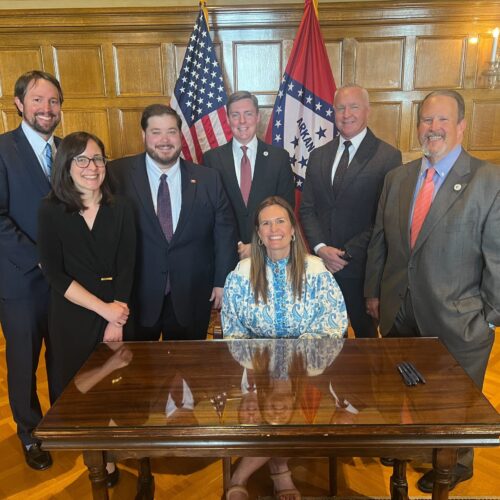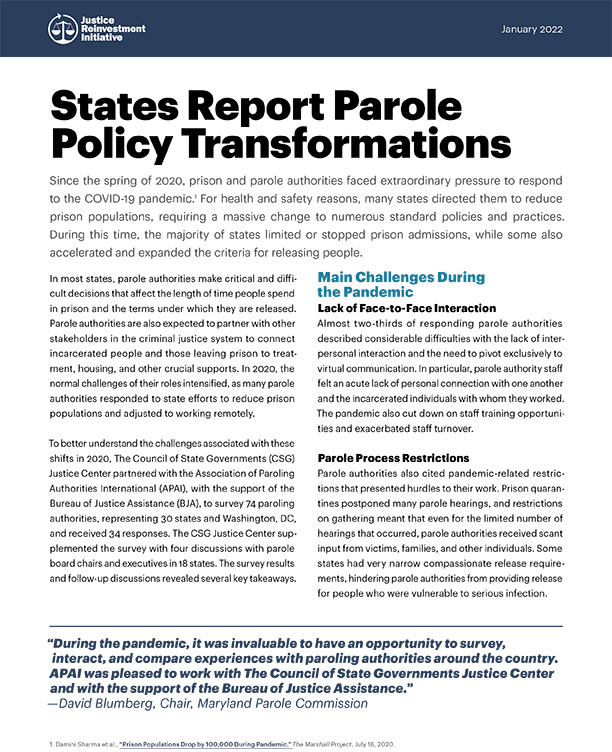States Report Parole Policy Transformations
In 2020, the normal challenges that parole authorities face intensified, as many responded to state efforts to reduce prison populations and adjusted to working remotely. To better understand the challenges associated with these shifts in 2020, The Council of State Governments (CSG) Justice Center partnered with the Association of Paroling Authorities International, with the support of the Bureau of Justice Assistance, to survey 74 paroling authorities, representing 30 states and Washington, DC, and received 34 responses. This brief summarizes the findings. Photo credit: Elnur via Shutterstock.
States Report Parole Policy Transformations
Since the spring of 2020, prison and parole authorities faced extraordinary pressure to respond to the COVID-19 pandemic.1 For health and safety reasons, many states directed them to reduce prison populations, requiring a massive change to numerous standard policies and practices. During this time, the majority of states limited or stopped prison admissions, while some also accelerated and expanded the criteria for releasing people.
In most states, parole authorities make critical and difficult decisions that affect the length of time people spend in prison and the terms under which they are released. Parole authorities are also expected to partner with other stakeholders in the criminal justice system to connect incarcerated people and those leaving prison to treatment, housing, and other crucial supports. In 2020, the normal challenges of their roles intensified, as many parole authorities responded to state efforts to reduce prison populations and adjusted to working remotely.
To better understand the challenges associated with these shifts in 2020, The Council of State Governments (CSG) Justice Center partnered with the Association of Paroling Authorities International (APAI), with the support of the Bureau of Justice Assistance (BJA), to survey 74 paroling authorities, representing 30 states and Washington, DC, and received 34 responses. The CSG Justice Center supplemented the survey with four discussions with parole board chairs and executives in 18 states. The survey results and follow-up discussions revealed several key takeaways.
Main Challenges During the Pandemic
Lack of Face-to-Face Interaction
Almost two-thirds of responding parole authorities described considerable difficulties with the lack of interpersonal interaction and the need to pivot exclusively to virtual communication. In particular, parole authority staff felt an acute lack of personal connection with one another and the incarcerated individuals with whom they worked. The pandemic also cut down on staff training opportunities and exacerbated staff turnover.
Parole Process Restrictions
Parole authorities also cited pandemic-related restrictions that presented hurdles to their work. Prison quarantines postponed many parole hearings, and restrictions on gathering meant that even for the limited number of hearings that occurred, parole authorities received scant input from victims, families, and other individuals. Some states had very narrow compassionate release requirements, hindering parole authorities from providing release for people who were vulnerable to serious infection.
Four Areas for Permanent Reform
Parole authorities identified several policy changes that align with evidence-based approaches to reduce prison populations, help people at the greatest risk of recidivism, and increase participation in the parole process.
1. Parole Violation Policies
Parole violations send a substantial number of people back to prison each year.2 During the pandemic, almost half of the responding parole authorities reported that they worked to limit the number of revocations for technical violations, like missing appointments or failing drug tests.
- Rhode Island parole violation admissions decreased by 29 percent, and technical violation admissions decreased 50 percent from 2019 to 2020.3
- Texas parole violation admissions decreased by 44 percent, and technical violation admissions decreased 50 percent from 2019 to 2020.4
2. Use of Technology
A necessity during the pandemic, virtual communication methods like videoconferencing technology (VCT)5 can help authorities that need to make urgent decisions during public health crises. In 2020, many parole authorities started conducting hearings, trainings, and public meetings through VCT. Sixteen percent of responding parole authorities stated that they would like to expand use of VCT for parole hearings moving forward.
- Connecticut livestreamed parole release and revocation hearings, which were open to the public. The state plans to continue this practice after the pandemic.6
- In March 2020, California Governor Gavin Newsom issued an executive order mandating the temporary use of videoconferencing for all scheduled parole hearings.7
3. Parole for Older and Medically Vulnerable People
During the pandemic, some states broadened their compassionate release eligibility (when a person facing circumstances such as terminal illness is released early) to include older adults and those with medical conditions who were at the greatest risk of contracting, or experiencing serious symptoms of, COVID-19. Thirty-eight percent of responding parole authorities reported that they enlarged the scope of compassionate releases during the pandemic. Parole authorities also stated that they would support automatic sentence review for older people as well as establishing a minimum age at which all people are eligible for parole.
- Kentucky Governor Andy Beshear commuted sentences for over 600 people identified as medically vulnerable by the Centers for Disease Control.8
- Washington, DC, implemented a new law allowing older people to request release for “extraordinary and compelling” reasons, which could include the pandemic.9
4. Discretionary Release Policies
To reduce the spread of the virus during the pandemic, some states expedited releases of people who were nearing the end of their sentence. Twenty-eight percent of responding parole authorities said they approved of expanding the type of sentences that could fall under this type of discretionary release, as well as accelerating those measures for people already within a defined period such as 180 days of release.
- New Jersey released more than 2,000 incarcerated people in one day in a coordinated response involving the legislature, governor, prisons, and parole authorities.10
- In Hawaii, the percentage of parole hearings resulting in approval was 18 percent higher in 2020 than in 2019.11
Endnotes
1. Damini Sharma et al., “Prison Populations Drop by 100,000 During Pandemic,” The Marshall Project, July 16, 2020.
2. The Council of State Governments Justice Center, Confined and Costly: How Supervision Violations Are Filling Prisons and Burdening Budgets (New York: The Council of State Governments Justice Center, 2019).
3. Confined and Costly: How Supervision Violations Are Filling Prisons and Burdening Budgets.
4. Ibid.
5. See the CSG Justice Center, Four Steps for Using Videoconferencing Technology for Parole Decision-Making.
6. “State of Connecticut Board of Pardons and Paroles,” State of Connecticut.
7. “Governor Newsom Issues Executive Order on State Prisons and Juvenile Facilities in Response to the COVID-19 Outbreak,” Office of Governor Gavin Newsom, March 24, 2020.
8. Kelly Dean, “Gov. Beshear commutes more medically vulnerable inmates, sentences almost up,” WBKO, August 26, 2020.
9. Ann E. Marimow, “Sick, elderly prisoners are at risk for covid-19. A new D.C. law makes it easier for them to seek early release,” The Washington Post, December 30, 2020.
10. Tracey Tully, “2,258 N.J. Prisoners Will Be Released in a Single Day,” The New York Times, November 4, 2020.
11. Tiana Herring, “Parole boards approved fewer releases in 2020 than in 2019, despite the raging pandemic,” Prison Policy Initiative, February 3, 2021.
Project Credits
Writing: Laura van der Lugt and Amelia Vorpahl, CSG Justice Center
Advising: Carl Reynolds and Jennifer Kisela, CSG Justice Center
Research: Jill Carle and Mari Roberts, CSG Justice Center
Editing: Leslie Griffin and Emily Morgan, CSG Justice Center
Design: Michael Bierman
Public Affairs: Brenna Callahan, CSG Justice Center
Web Development: Eleventy Group
This project was supported by Grant No. 2019-ZB-BX-K002 awarded by the Bureau of Justice Assistance. The Bureau of Justice Assistance is a component of the Department of Justice’s Office of Justice Programs, which also includes the Bureau of Justice Statistics, the National Institute of Justice, the Office of Juvenile Justice and Delinquency Prevention, the Office for Victims of Crime, and the SMART Office. Points of view or opinions in this document are those of the author and do not necessarily represent the official position or policies of the U.S. Department of Justice.
Arkansas policymakers have long expressed concerns about the state’s high recidivism rate. Over the past 10 years, an…
Read MoreIn April 2025, Arkansas Governor Sarah Huckabee Sanders signed a package of bipartisan criminal justice legislation into law,…
Read More Explainer: Key Findings and Options from Arkansas’s Justice Reinvestment Initiative
Explainer: Key Findings and Options from Arkansas’s Justice Reinvestment Initiative
Arkansas policymakers have long expressed concerns about the state’s high recidivism rate.…
Read More Explainer: How a New Law in Arkansas Tackles Crime, Recidivism, and Community Supervision Challenges
Explainer: How a New Law in Arkansas Tackles Crime, Recidivism, and Community Supervision Challenges
In April 2025, Arkansas Governor Sarah Huckabee Sanders signed a package of…
Read More












